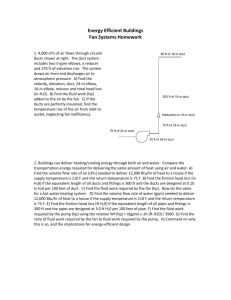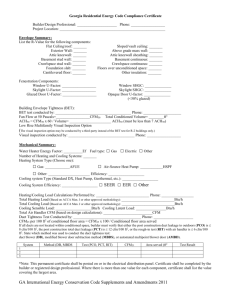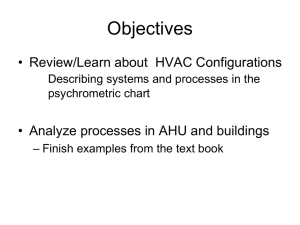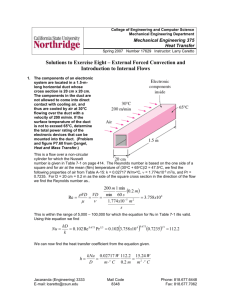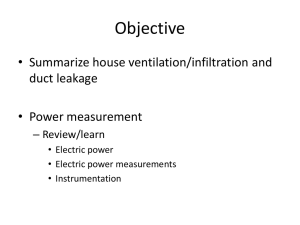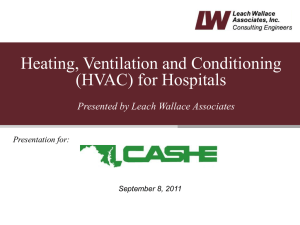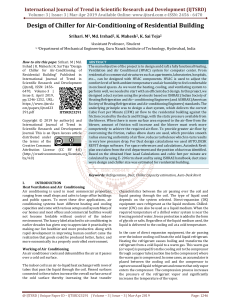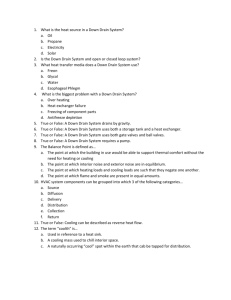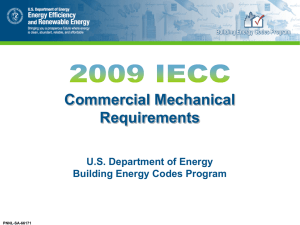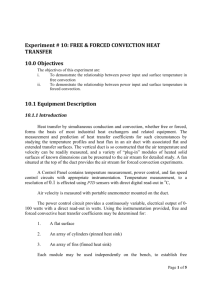Student Name
advertisement
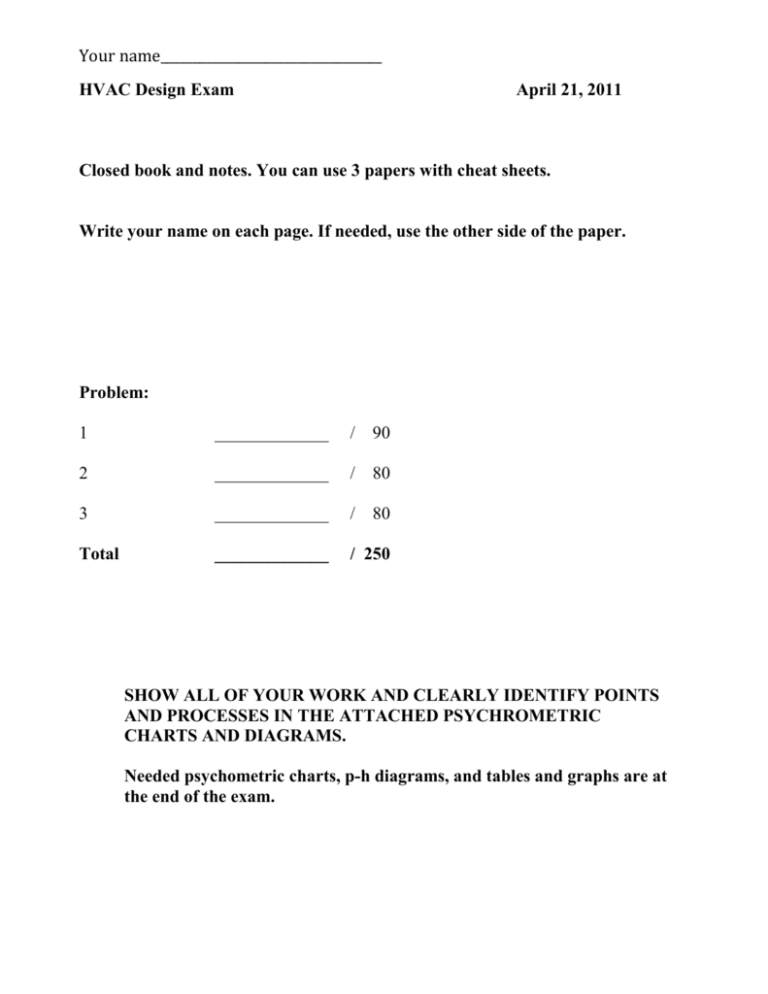
Your name__________________________________ HVAC Design Exam April 21, 2011 Closed book and notes. You can use 3 papers with cheat sheets. Write your name on each page. If needed, use the other side of the paper. Problem: 1 _____________ / 90 2 _____________ / 80 3 _____________ / 80 Total _____________ / 250 SHOW ALL OF YOUR WORK AND CLEARLY IDENTIFY POINTS AND PROCESSES IN THE ATTACHED PSYCHROMETRIC CHARTS AND DIAGRAMS. Needed psychometric charts, p-h diagrams, and tables and graphs are at the end of the exam. Your name__________________________________ Problem 1 You are designing a restroom exhaust duct system presented in figure below using equal static pressure method. Part 1a: Calculate the pressure drop from the restroom A to the exhaust fan F and from the restroom B to F. Use the round ducts (table is attached). Static pressure should be in the range of 2 to 5 Pa/m. Balance the system. For your duct, select the fan from the fan catalog (see attachment). Calculate the fan power requirement if the combine fan and electric motor efficiency is 50%. Your name__________________________________ Part 1b: What would happen with the power for the fan if you double the diameter in each section of your duct? (You don’t need to redesign the whole exhaust duct system). Part 1c: Draw the static and dynamic pressure diagram (like the one below) for branch F-B for equal friction method and static regain method. You don’t need to provide exact numbers - just schematics. Example of static and dynamic pressure diagram: (1) equal friction method (2) static regain method Your name__________________________________ Problem 2 Chiller problem Part 2a The outdoor air is at 90°F and 30% RH and you need to cool the water to 40°F. - What is the absolute maximum COP of your cooling system if you have air cooled condenser. - What is the absolute maximum COP of your cooling system if you have cooling tower with the maximum possible efficiency (perfect cooling tower). Part 2b If you decide to use air cooled condenser and the condensation temperature is 20 °F higher than air temperature and evaporation temperature is 10°F below the water temperature select the refrigerant (among Ammonia or R- 22) for the best COP with the single stage compression cycle. (R- 22 and ammonia chart are provided as attachment). Explain why you selected certain refrigerant. Calculate the COP for the selected refrigerant. Your name__________________________________ Part 2c Explain the principle of operation of Thermostatic Expansion Valve (TXV) and Automatic Expansion Valve (AEV). Which one is better for your installation? Explain why! Your name__________________________________ Problem 3 For the DUAL DUCT SYSTEM in the figure below temperature in the room is controlled by mixing hot and cooled air. Since this system provides 100% fresh air to labs in NSM building at UT (no recirculation), heat recovery system is used. Using enthalpy and heat (sensible) wheels in the air handling unit (AHU) for this building large fraction of heating and cooling energy is recovered. The detailed schematic of AHU wheel is provided in figure below. Your name__________________________________ Part 3a) Summer period: - Temperature of indoor air (return air) is 24°C and relative humidity is 55% - Temperature of outdoor air is 33°C and relative humidity is 35% - Temperature in supply cold air duct is controlled to 13°C and in hot air to 24°C. - Preheater is off. - Temperature of the surface of the cooling coil is 8°C. - Sensible (heat) wheel control the temperature at point 4 at 20°C. - Effectiveness of the enthalpy wheel is 75% (heat exchanger effectiveness) - You can assume that heat dissipation of fan motors have minimal impact on air temperature Provide schematic of air-conditioning in attached Psychrometric charts for summer period (mark all points and processes for return air flow path A, B, C, D and fresh air flow: 1, 2, 3, 4, 5, 6, 7). What is the temperature of air at point D? Calculate the required effectiveness for the sensible (heat) wheel needed to provide temperature of point 4. Part 3b) Winter period: - Temperature of indoor air (return air) is 24°C and relative humidity is 55% - Temperature of outdoor air is 0°C and relative humidity is 80% - Temperature in supply cold air duct is controlled to 13°C and in hot air to 34°C. - Cooling coil is off. - Preheater control the temperature at point 2 at 8°C. - Effectiveness of the enthalpy wheel is 75% (heat exchanger effectiveness). - Assume that heat dissipation of fan motors have minimal impact on air temperature. Provide schematic of air-conditioning in the second attached Psychrometric charts for winter period (mark all points and processes for return air flow path A, B, C, D and: 1, 2, 3, 4, 5, 6, 7). What is the temperature of air at point D? Calculate the required effectiveness for the sensible (heat) wheel needed to provide temperature of point 4. Your name__________________________________ Part 3c) Sizing the AHU component: If the maximum (design) flow rate in the winter and summer period in the cooled and hot duct is the same and equal to V=10 m3/s. - Size the preheater (just determine the heating requirement): - Size the cooling coil: - Size the heating coil: Your name__________________________________ Your name__________________________________

